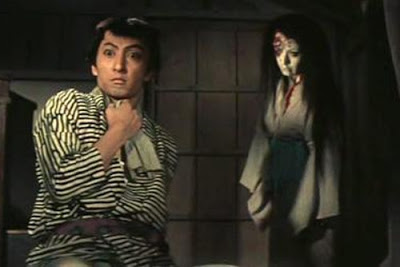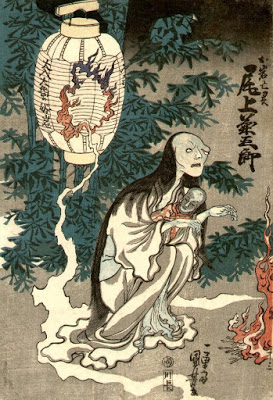Four from the Godfather of
Japanese Horror - Nobuo Nakagawa
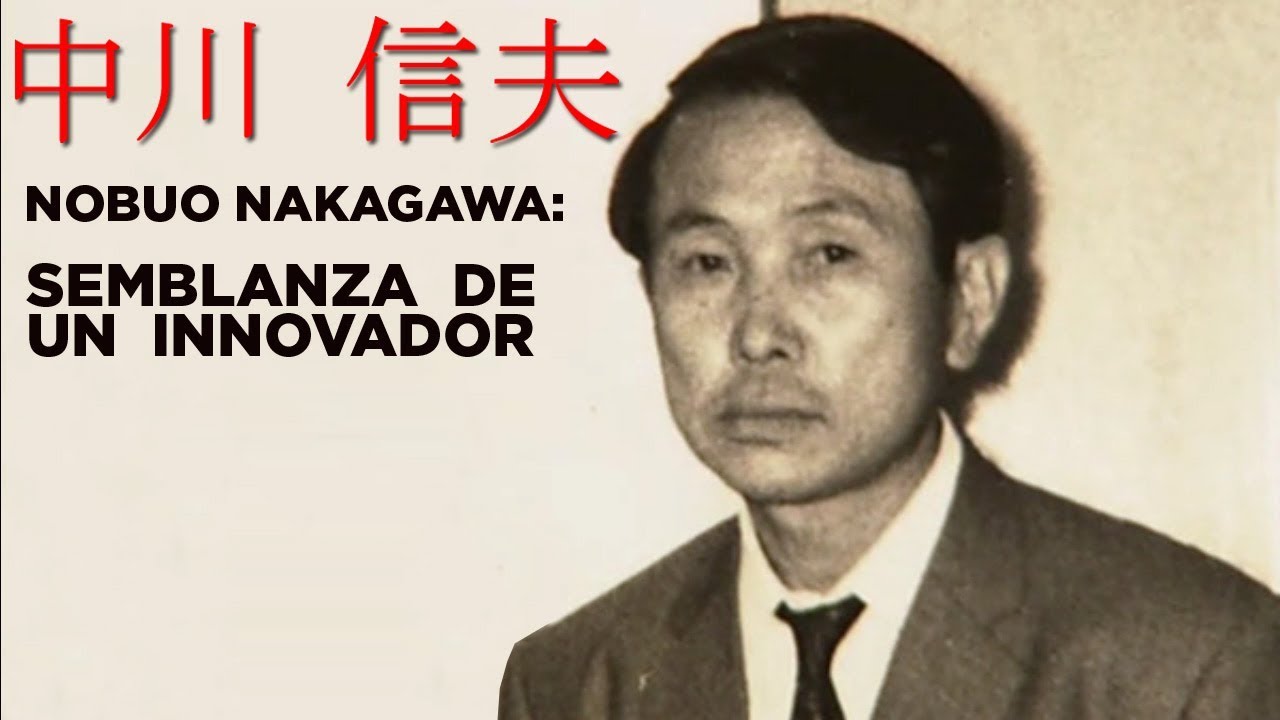
The Lady Vampire (1959) - 7.0
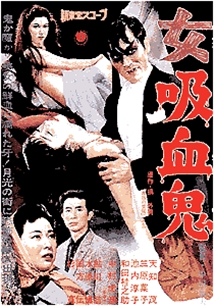
A.k.a. - The Woman Vampire
It is nighttime in Tokyo and Itsuko (Junko
Ikeuchi) is celebrating her birthday at her home with a group of friends
dancing and cutting cake. She slices her finger while doing so and her father
and butler give each other a look that says "oh hell". She gets an unexpected
gift later that night. Her mother (Yoko Mihara). The mother disappeared twenty
years ago when Itsuko was a baby and now she has returned. Looking exactly
the same. Not a day older. And in a near trace. But hey mom is back, let's
celebrate. The doctor says it makes no sense but why worry. The next day
Itsuko and her fiancée spot a painting at an exhibition in which the
scantily clad female looks exactly like the mother. What a co-incidence.
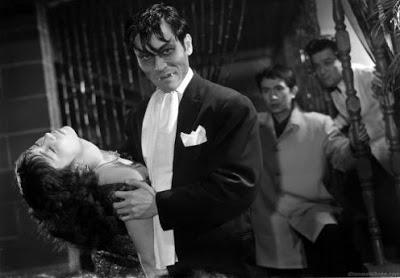
Neither really notice the man loitering
about looking very suave in his well-pressed clothes and sunglasses. This
is Shiro (Shigeru Amachi) who eavesdrops on their conversation. A nice enough
guy until the moon comes out and catches him in it. That old devil moon.
He is a vampire of sorts who has no trouble in the daylight but the moon's
rays turn him into a monster who appreciates the neck of a woman. Don't we
all. So sort of a werewolf vampire. Only known to exist in Japan. He has
been holding on to the mother all these years not allowing her to get older
- with the help of his dwarf, an old witch woman and a bald-headed giant
of a man. In their castle buried beneath rocks with their very own acid pool
and a group of captive women.
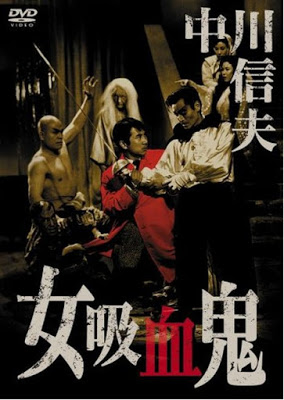
This is fairly enjoyable though the horror
aspects don't exactly scare these days - I expect more so in 1959 - but the
black and white atmospherics are enjoyable and the requisite creepy music
is on hand. Some good scenes - Shiro gets caught in the moonlight and runs
into a downstairs bar in the heart of the city - but the dwarf follows him
and breaks a window allowing the moon to find its way in turning Shiro into
a monster of gnashing teeth where he goes on a rampage - a veritable buffet
of women's necks - and whether the director was trying to say something or
not - literally no one tries to stop this from happening. No heroes here.
Let him eat. He will go away once he has his fill.
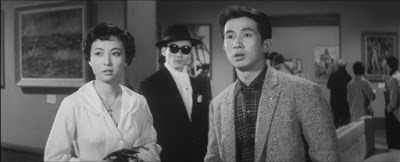
This director of course is Nobuo Nakagawa,
called among many things the Godfather of Japanese horror. There had been
ghost films before Nobuo but he took them to a harder, more graphic level
- clearly influenced by Western horror films. His horror films are littered
with ghosts (kaidan), vampires, deadly cats and other supernatural creatures.
Though certainly influenced by the West in terms of style, his stories also
are deeply influenced by Japanese folk tales. Interestingly, his directing
career began back in the 1930's and for two decades (with a break for duty
in WWII), most of his films were comedy, crime and samurai films. It wasn't
until the 1950's when he signed up with Shin Toho and directed a flurry of
horror films from 1957 to 1962 until he left Shin Toho and then made only
a few supernatural tales thereafter. For years Nobuo was generally unknown
to the West but a number of his horror films have made it to DVD and there
have been a few festivals that have exhibited a number of his films. His
influence of J-horror is considered immense.
The Ghost of Kasane (1957) - 7.0
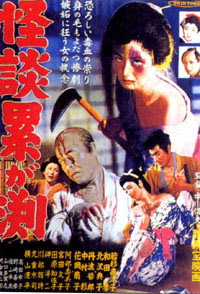
AKA - The Depths
A hard snow is falling in this ill-fated
supernatural tale from Nobuo Nakagawa as it opens in 1773. A blind masseur
is going out in it though to collect money owed him because as he tells his
servant and young daughter he knows people will be home on a night like this.
Unfortunately for him this is true. A broke samurai kills him and has his
servant throw his body in the Kasane Swamp. The blind man's ghost comes back
for revenge as they tend to. The servant than takes the samurai's orphan
baby son to Edo and leaves it on a doorstep. Twenty years later karma works
its fate. As the masseur's now old servant says "What strange tricks fate
plays". Yes they do especially if ghosts are involved. Though this has ghosts
and a disfigured face and revenge, most of that bookends the film with a
soap operish drama sandwiched in between - an Edo tragic love quadrangle.
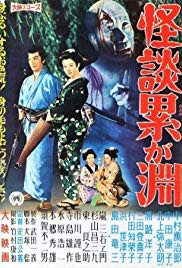
The baby boy Shinkichi (Takashi Wada) is
now a servant for the wealthy family where he was left. Unfailingly polite
as he is, the daughter Hisa (Noriko Kitazawa) of the rich merchant has fallen
in love with Shinkichi. He is a servant and she is promised to another. Not
a good combination. And then it turns out that Hisa's Samisen teacher Rui
(Katsuko Wakasugi) is also in love with Shinkichi - madly in love - which
is a little difficult to understand as he has the personality of fence post.
Two beautiful women in love with this meek namby-pamby - he must be hiding
something under his Yukata. Throw in a samurai (Tetsurô Tanba) in love
with Rui and you have the makings of a steamy potboiler. Especially when
we find out Rui is of course the daughter of the murdered masseur. And Shinkichi
the son of his killer. Karma really is a bitch.
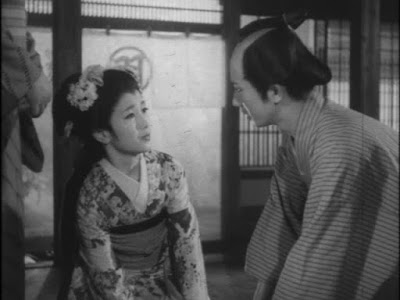
This is based on a play written by Enchô
San'yûtei back in the 1860's. It has been adapted for film many times
and is considered a classic story in Japanese literature. Shot in black and
white with excellent period detail, this is quite good, elegant and at 66
minutes fairly speedy - though a more masculine actor for Shinkichi would
have felt more appropriate - but perhaps in those days women preferred gentle
and cowardly. I think this is Nobuo Nakagawa first horror film for Shin Toho.
The Mansion of the Ghost Cat (1958) - 8.0
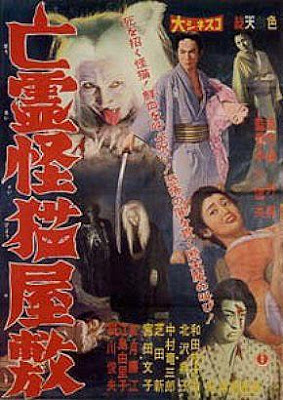
AKA Black Cat Mansion
Japanese folk tales are full of supernatural
cats - yokai that can be translated to ghosts, demons, spirits. In particular
yokai cats are broken into two categories - Nekomata which is scary in name
alone and the more common Bakeneko that can turn itself into human form and
talk. This film is based on one of the more famous Bakeneko folk tales -
called the Nabeshima bakeneko disturbance from the 1600's that became a play
and later a few films.
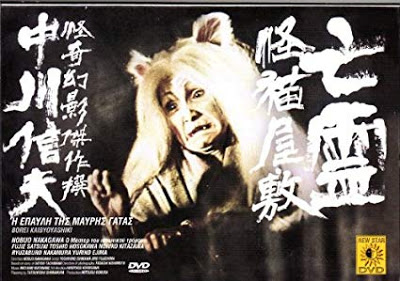
This was director Nobuo Nakagawa first
real hit and deservedly so. It is brilliant at times with stunning photography,
music and editing and a ghost story that keeps you on your toes. There are
a few scenes here that were spellbinding for their artistry and imagination
- one in particular often playing out in silhouette through Japanese paper
walls that is a dance of death - murder in ballet. I don't think I have seen
murder so beautifully choreographed. The film is multi-flashback - back to
back to back crammed into a mere 67 minutes that pulls you in.
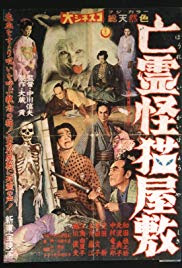
It begins with doctor Kuzumi (Toshio Hosokawa)
sitting in his office late at night when the electricity goes out and he
hears footsteps coming down the dark hallway. This causes him to recall an
incident that happened a few years previously. His wife Yoriko (Yuriko Ejima)
has come down with tuberculosis and they decide to move from Tokyo to Kyushu
for its cleaner air. Her brother in his infinite wisdom gets them an old
decrepit overrun mansion to live in with steep steps and a reputation of
being haunted. It is. An old hag with long white hair and a hideous face
keeps trying to kill Yoriko to which her husband continues to tell her that
she is imagining things. Give him a good slap Yoriko. Finally a priest intervenes
and tells them the story of its haunting which goes back hundreds of years.
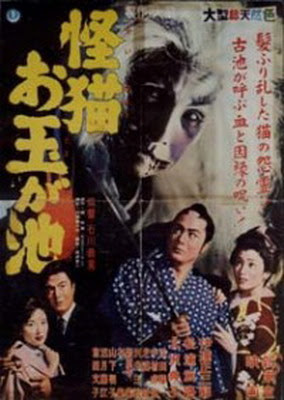
And suddenly the film turns from black
and white to brilliant vibrant color. This flashback is the heart of the
film. Quite wonderful. A mother in desperation asks her cute little cat to
revenge the family – to lick her blood after she kills herself and to be
filled with fury and hate as she is. It seems a lot to put on a cat – as
it takes on human forms but can’t help itself from catching fish in the pond
and licking its bloody hands – cats will be cats - and now in modern times
it seems its duty is unfinished.
The Ghost of Yotsuya (1959) - 7.5
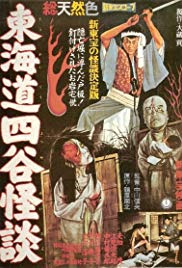
Jigoku (Hell) and this film are considered
by most film critics to be Nobuo Nakagawa's two masterpieces. I have yet
to see Jigoku and have to admit to liking Mansion of the Ghost Cat a bit
more than this one - pulpier and more fun. But this is pretty darn good -
sort of bi-polar with the first half being a period tale of love, murder
and revenge before it turns into a fantastic tragic grand guignol of the
supernatural. It is all beautifully designed with splashing colors and great
period detail. It begins with a short theatrical opening that speaks to its
roots as a 19th century Kabuki play. The film keeps that sense of theatricality
throughout with stark moments of drama, action that is choreographed almost
as dance between partners, colors that pop out and horror that is more expressive
than gory.
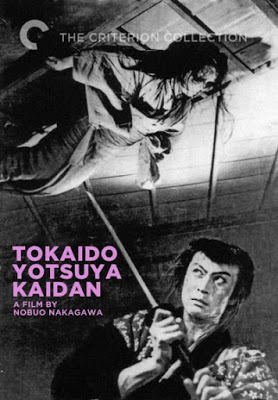
A lowly samurai named Lemon (Shigeru Amachi
- Lady Vampire) is refused from marrying the daughter of a high-class samurai.
So he does the only thing he can - he kills the father and two others - covers
it up, marries the daughter Iwa and takes her (Katsuko Wakasugi) and her
sister Sode (Noriko Kitazawa - Mansion of the Ghost Cat and Ghost of Kasane
Swamp) to look for the killer. Which is him of course. In their long search
Lemon begins to realize being poor with a nagging wife isn't what he expected
and a wealthier daughter is offered to him.
So he does the only thing he can. And that
is when the fun begins. The thing about ghosts in general and Japanese ghosts
in particular are they like tormenting you first. Tricking you into killing
others. Stuck on the ceiling watching you. Popping up at the most unexpected
times. With a face that a mother could not love. It is all good fun with
a few thrills and chills but mainly it just looks good. I would love to see
this on the big screen.















